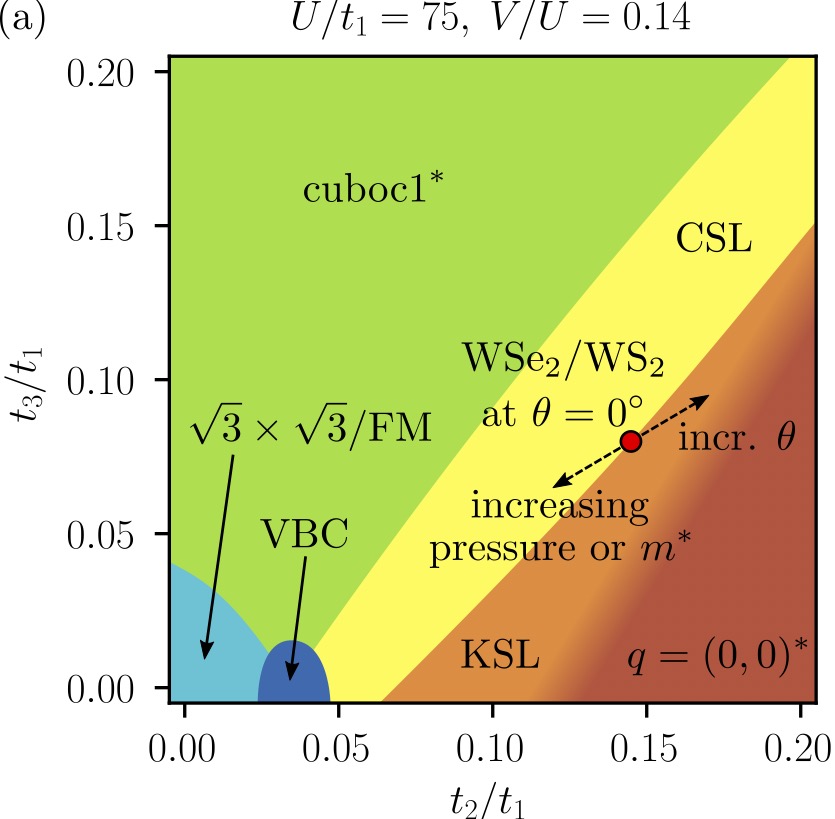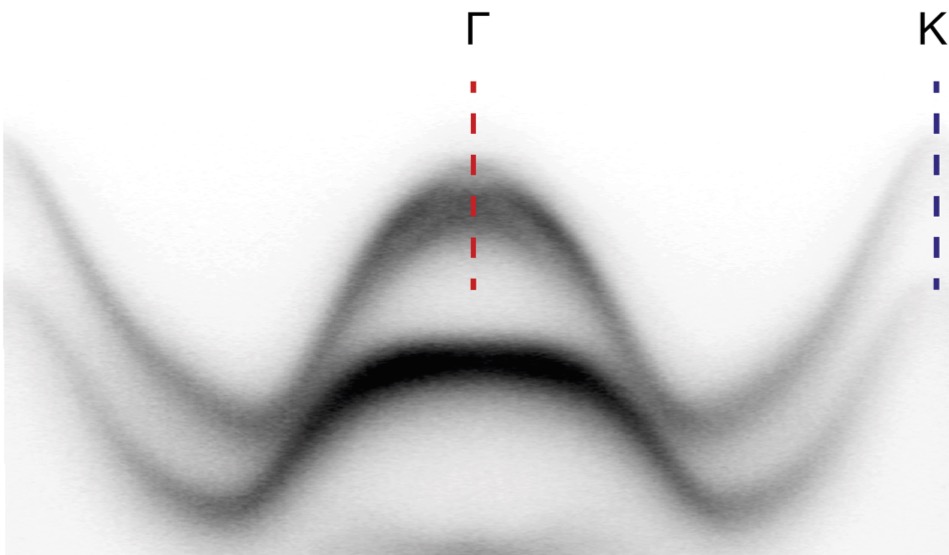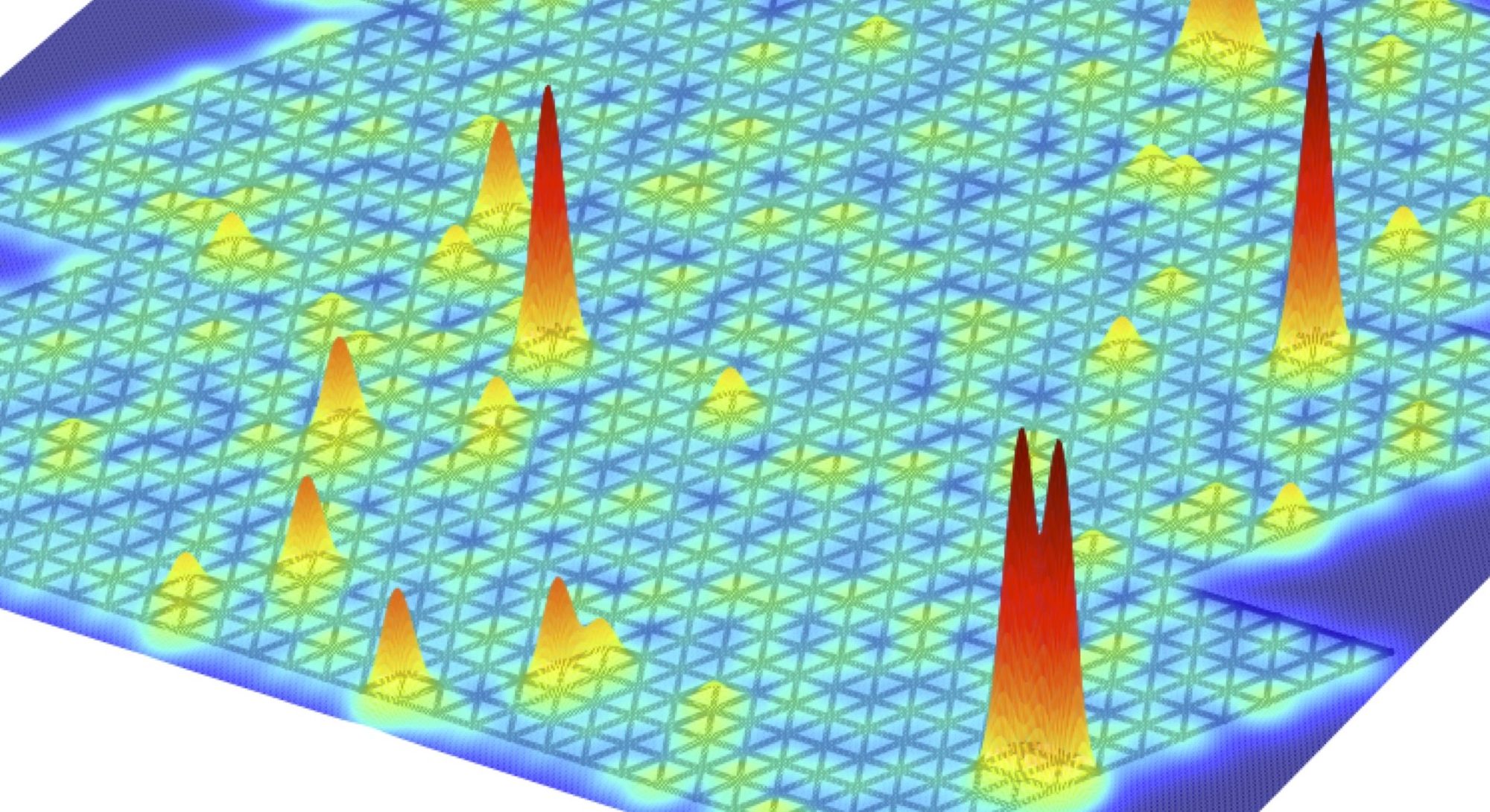At n=3/4 filling of the moiré flat band, transition metal dichalcogenide moiré bilayers will develop kagome charge order. We derived an effective spin model for the resulting localized spins and study its phase diagram using density matrix renormalization group simulations. Using realistic model parameters relevant for WSe2/WS2, we showed that this material can realize the exotic chiral spin liquid phase and the highly debated kagome spin liquid. Our work thus shows that the frustration and strong interactions present in TMD heterobilayers provide an exciting platform to study spin liquid physics.
Johannes Motruk, Dario Rossi, Dmitry A. Abanin, Louk Rademaker
arXiv:2211.15696
Observation of flat Γ moiré bands in twisted bilayer WSe2
I provided the theory for a wonderful ARPES experiment that revealed the presence of flat bands in twisted bilayer WSe2. To our surprise, we only saw the flat bands around Γ and not at K — where they were to be expected based on all other (transport, exciton, STM) experiments. So some new mysteries to solve! Now available on the arXiv:
Title: Observation of flat Γ moiré bands in twisted bilayer WSe2
Reference: arXiv:2211.01192
Gianmarco Gatti, Julia Issing, Louk Rademaker, Florian Margot, Tobias A. de Jong, Sense Jan van der Molen, Jérémie Teyssier, Timur K. Kim, Matthew D. Watson, Cephise Cacho, Pavel Dudin, José Avila, Kumara Cordero Edwards, Patrycja Paruch, Nicolas Ubrig, Ignacio Gutiérrez-Lezama, Alberto Morpurgo, Anna Tamai, Felix Baumberger
The recent observation of correlated phases in transition metal dichalcogenide moiré systems at integer and fractional filling promises new insight into metal-insulator transitions and the unusual states of matter that can emerge near such transitions. Here, we combine real- and momentum-space mapping techniques to study moiré superlattice effects in 57.4∘ twisted WSe2 (tWSe2). Our data reveal a split-off flat band that derives from the monolayer Γ states. Using advanced data analysis, we directly quantify the moiré potential from our data. We further demonstrate that the global valence band maximum in tWSe2 is close in energy to this flat band but derives from the monolayer K-states which show weaker superlattice effects. These results constrain theoretical models and open the perspective that Γ-valley flat bands might be involved in the correlated physics of twisted WSe2.
Doping a Wigner-Mott insulator: Electron slush in transition-metal dichalcogenide moiré heterobilayers
Authors: Yuting Tan, Pak Ki Henry Tsang, Vladimir Dobrosavljević, Louk Rademaker
Abstract: The moiré pattern induced by lattice mismatch in transition-metal dichalcogenide heterobilayers causes the formation of flat bands, where interactions dominate the kinetic energy. At fractional fillings of the flat valence band, the long-range electron interactions then induce Wigner-Mott crystals. In this Letter we investigate the nontrivial electronic phases appearing away from commensurate fillings. Here, competing phases arise that are either characterized as doped Wigner-Mott charge transfer insulators or alternatively, a novel state with frozen charge order yet is conducting: the ‘electron slush’. We propose that an extremely spatially inhomogeneous local density of states can serve as a key signature of the electron slush.
Reference: arXiv:2210.07926 (2022)
Spin-Orbit Coupling in Transition Metal Dichalcogenide Heterobilayer Flat Bands
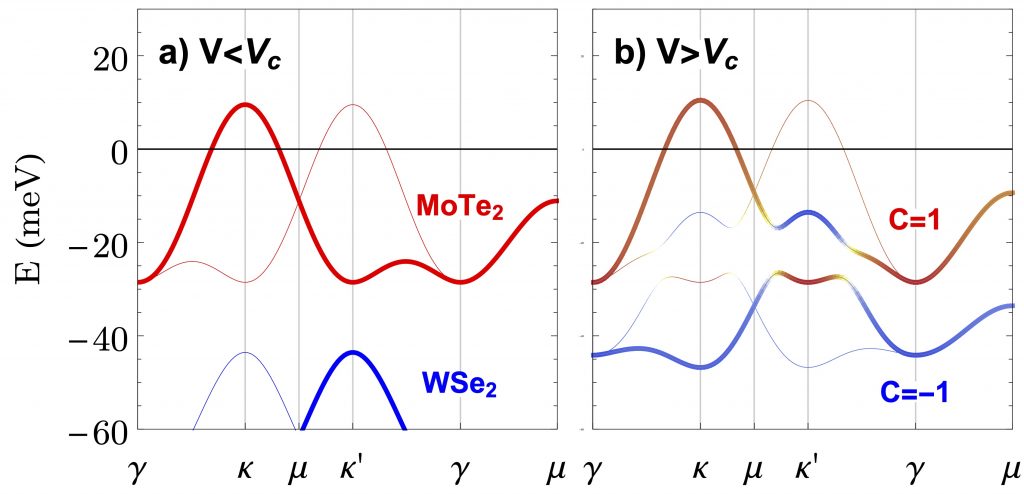
To my surprise I found out that the flat bands of TMD heterobilayers automatically have a spin-orbit coupling that makes them realizations of the Kane-Mele model. This is different from the original Wu-MacDonald model where they say its a triangular lattice Hubbard model. Now on the arXiv!
Spin-Orbit Coupling in Transition Metal Dichalcogenide Heterobilayer Flat Bands
Louk Rademaker, arXiv:2111.06208
Abstract: The valence flat bands in transition metal dichalcogenide (TMD) heterobilayers are shown to exhibit strong intralayer spin-orbit coupling. This is reflected in a simple tight-binding model with spin-dependent complex hoppings based on the continuum model. A perpendicular electric field causes interlayer hybridization, such that the effective model is equivalent to the Kane-Mele model of topological insulators. The proposed model can be used as a starting point to understand interactions and the experimentally observed topological phases.
Scaling Theory of Few-Body Delocalization
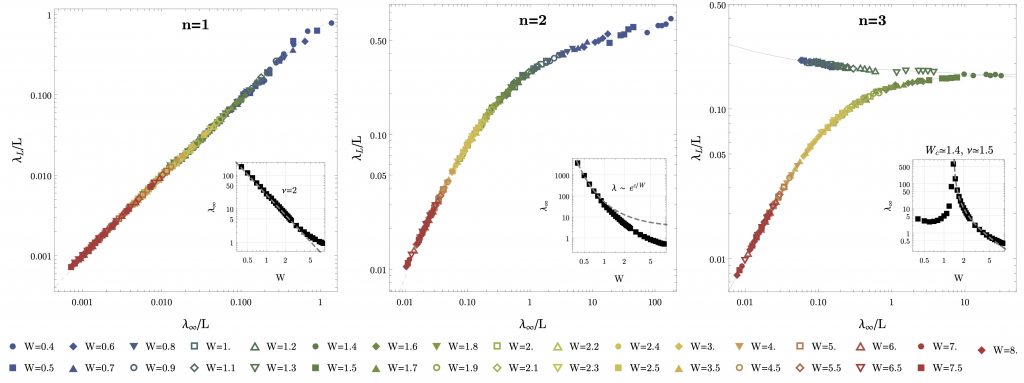
I’m quite proud of my latest single-author paper, in which I explore a new direction in the field of disordered interacting systems. I dub it: “Few-Body Delocalization“, and I investigate the question: given that single-particle states are all localized in d ≤ 2 dimen- sions, how can many-particle states become delocalized?
In the end, using scaling theory and some numerics I show that there exists a delocalization transition for n-particle bound states in d dimensions when n + d ≥ 4. Read more on arXiv:2107.06364.
Topological Flat Bands and Correlated States in Twisted Monolayer-Bilayer Graphene

We have been working on twisted monolayer bilayer graphene (tMBG) for a while when suddenly three groups put their experimental results last week on the arXiv (UCSB, Columbia, Manchester). So we had to rush writing up everything we had, and now you can read our postdictions about the quantum anomalous Hall effect in tMBG!
Title: Topological Flat Bands and Correlated States in Twisted Monolayer-Bilayer Graphene
Authors: Louk Rademaker, Ivan Protopopov, Dmitry Abanin
Abstract: Monolayer graphene placed with a twist on top of AB-stacked bilayer graphene hosts topological flat bands in a wide range of twist angles. The dispersion of these bands and gaps between them can be efficiently controlled by a perpendicular electric field, which induces topological transitions accompanied by changes of the Chern numbers. In the regime where the applied electric field induces gaps between the flat bands, we find a relatively uniform distribution of the Berry curvature. Consequently, interaction-induced valley- and/or spin-polarized states at integer filling factors are energetically favorable. In particular, we predict a quantum anomalous Hall state at filling factor ν=1 for a range of twist angles 1<θ<1.4. Furthermore, to characterize the response of the system to magnetic field, we computed the Hofstadter butterfly and the Wannier plot, which can be used to probe the dispersion and topology of the flat bands in this material.
Reference: arXiv:2004.14964
Direct evidence for flat bands in twisted bilayer graphene from nano-ARPES
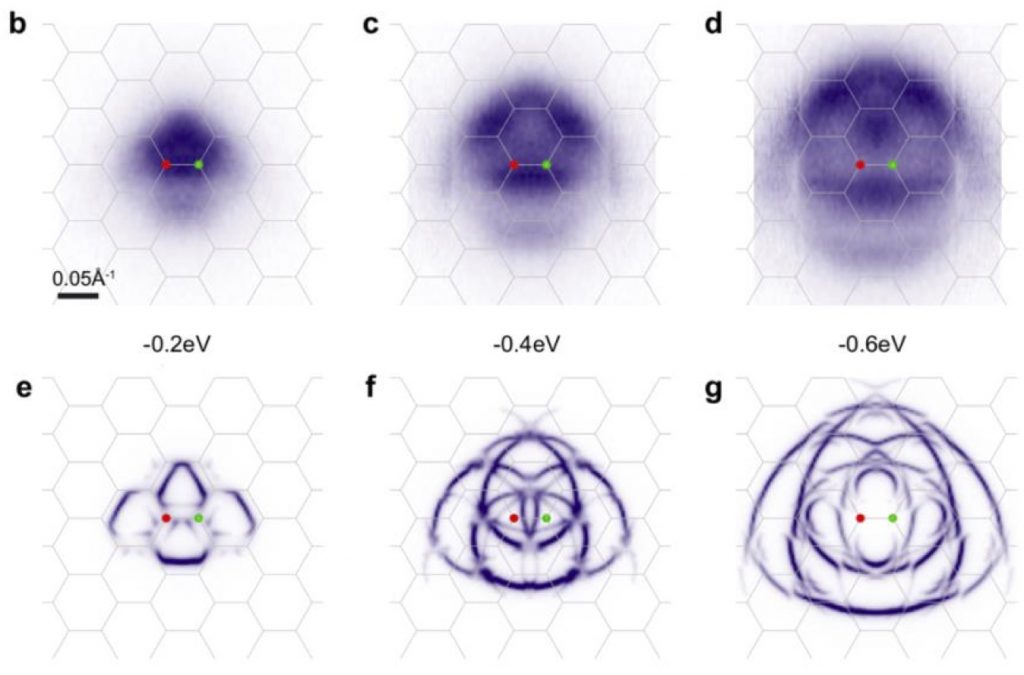
Today our paper appeared on the arXiv describing the evidence for flat bands in twisted bilayer graphene. A really great effort, with experiments in Leiden and Barcelona and with our local Genevan Simone Lisi leading the ARPES effort. I’m very happy to have provided some theoretical work on this.
Read more on the arXiv…
Aspects of forward scattering in FeSe thin films
Last year we showed that you get ridiculously high superconducting temperatures if the electron-phonon coupling is strongly peaked around zero momentum transfer, so-called forward scattering. While the paper from that time is just accepted in the New Journal of Physics, we came up with a new paper discussing many of the more subtle details – for example about the vertex corrections, quasiparticle interference and gap structure. This week on the arXiv!
(PS: I’ve updated the publication list, a lot of things from last year are now peer-reviewed published somewhere, such as our MBL-paper in Physical Review Letters, or the topological classification in Phys. Rev. B!)
Title: Aspects of electron-phonon interactions with strong forward scattering in FeSe Thin Films on SrTiO3 substrates
Y. Wang, K. Nakatsukasa, L. Rademaker, T. Berlijn, and S. Johnston
Abstract: Mono- and multilayer FeSe thin films grown on SrTiO3 and BiTiO3 substrates exhibit a greatly enhanced superconductivity over that found in bulk FeSe. A number of proposals have been advanced for the mechanism of this enhancement. One possibility is the introduction of a cross-interface electron- phonon (e-ph) interaction between the FeSe electrons and oxygen phonons in the substrates that is peaked in the forward scattering (small q) direction due to the two-dimensional nature of the interface system. Motivated by this, we explore the consequences of such an interaction on the superconducting state and electronic structure of a two-dimensional system using Migdal-Eliashberg theory. This interaction produces not only deviations from the expectations of conventional phonon-mediated pairing but also replica structures in the spectral function and density of states, as probed by angle-resolved photoemission spectroscopy, scanning tunneling microscopy/spectroscopy, and quasi-particle interference imaging. We also discuss the applicability of Migdal-Eliashberg theory for a situation where the e-ph interaction is peaked at small momentum transfer and in the FeSe/STO system.
arXiv preprint: Impurity Bound States and Greens Function Zeroes as Local Signatures of Topology
Title: Impurity Bound States and Greens Function Zeroes as Local Signatures of Topology
Abstract: We show that the local in-gap Greens function of a band insulator G0(ϵ,k∥,r⊥=0), with r⊥ the position perpendicular to a codimension-1 or -2 impurity, reveals the topological nature of the phase. For a topological insulator, the eigenvalues of this Greens function attain zeros in the gap, whereas for a trivial insulator the eigenvalues remain nonzero. This topological classification is related to the existence of in-gap bound states along codimension-1 and -2 impurities. Whereas codimension-1 impurities can be viewed as ‘soft edges’, the result for codimension-2 impurities is nontrivial and allows for a direct experimental measurement of the topological nature of 2d insulators.
Reference: Robert-Jan Slager, Louk Rademaker, Jan Zaanen, Leon Balents, arXiv:1504.04881 (2015)
arXiv preprint: Glassy dynamics in geometrically frustrated Coulomb liquids without disorder
Title: Glassy dynamics in geometrically frustrated Coulomb liquids without disorder
Abstract: We show that introducing long-range Coulomb interactions immediately lifts the massive ground state degeneracy induced by geometric frustration for electrons on quarter-filled triangular lattices in the classical limit. Important consequences include the stabilization of a stripe-ordered crystalline (global) ground state, but also the emergence of very many low-lying metastable states with amorphous “stripe-glass” spatial structures. Melting of the stripe order thus leads to a frustrated Coulomb liquid at intermediate temperatures, showing remarkably slow (viscous) dynamics, with very long relaxation times growing in Arrhenius fashion upon cooling, as typical of strong glass formers. On shorter time scales, the system falls out of equilibrium and displays the aging phenomena characteristic of supercooled liquids above the glass transition. Our results show remarkable similarity with the recent observations of charge-glass behavior in ultra-clean triangular organic materials of the θ-(BEDT-TTF)2 family.

